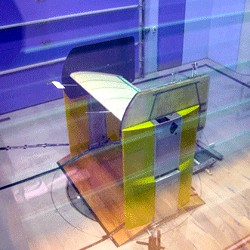Denmark’s National Laboratory for Sustainable Energy and three corporate partners have developed a controllable trailing edge for wind turbine blades that can reduce loads on turbines and help reduce the cost of electricity from wind power. The lab, known as Risø DTU, is part of the Technical University of Denmark in Roskilde.
Wind turbines are exposed constantly to strong gusts and turbulence that contribute to the cost of producing electricity from wind. The turbines must be designed to withstand these stresses during their 20-year lifespans, since repairs to turbine blades can be costly. Many wind farms are in remote locations or far out at sea, and stand more than 100 meters high.
The solution to this problem by Risø DTU is a flexible trailing edge of rubber or plastic. Elastic deformations caused by fiber reinforced cavities that run through the rear of the blade allow movement of the trailing edge, which can also be pressurized with air or hydraulics. These controlled movements can counteract the forces from the strong wind gusts, reducing the loads on turbines and making it easier for the turbines to generate power.
Risø DTU’s research specialist Helge Aagaard Madsen notes that the turbine’s pitch system rotates the blades so that they are in an optimal position towards the wind. The costs of both loads and energy to turn a 15-ton rotor blade, however, are much higher than the added cost of small movements by the flexible trailing edge that weighs about one percent of the blade’s total weight.
The technology has been tested in the lab and in wind tunnels, and the Risø DTU team is now producing a prototype to be fitted on a full-scale turbine. “We want to develop and produce prototypes in 2m-long rubber or plastic in the project, depending on what’s most robust and give the best result,” says Madsen.
The three industrial partners in the project are AVN Energy A/S, Rehau A/S and Dansk Gummi Industri A/S. AVN Energy brings expertise in the hydraulics currently in use for turbine pitch systems. Rehau supplies plastic parts for the auto industry and Dansk Gummi Industri manufactures molded rubber and polyurethane, which they can adapt to turbine blades.
Read more: Laser Measurement Device Deployed for Europe Wind R&D
* * *


 RSS - Posts
RSS - Posts
[…] Wind Turbine Blade Edge Helps Reduce Power Costs | Science Business […]
[…] Wind Turbine Blade Edge Helps Reduce Power Costs | Science Business […]
[…] Wind Turbine Blade Edge Helps Reduce Power Costs | Science Business […]
[…] Read more: Wind Turbine Blade Edge Helps Reduce Power Costs […]
[…] Read more: Wind Turbine Blade Edge Helps Reduce Power Costs […]